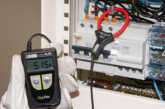
Di-Log’s Dave Sweetman debunks a few of the common myths surrounding test and measurement equipment.
MYTH: My Loop Zs result should match my calculated Ze+ (R1+R2) value.
FALSE: There are a lot of factors as to why the measured Zs results will always be higher than the calculated result, especially when an RCD is fitted for protection. Technology and IT equipment is increasingly used in our homes and offices, creating distorted waveforms due to noise on the relevant circuits.
Although manufacturers are continuously developing new methods to overcome some issues, this problem will never be fully eradicated. More commonly, electricians can experience RCD ‘uplift’; RCD coils are becoming increasingly inductive as the market growth is driving the price of components down. Commonly, your loop measurement will always be higher due to the different method each manufacturer used to measure Earth Loop Impedance.
MYTH: 1. My Check Box replaces the need for annual calibration. 2. My inspector says I don’t need annual calibration if I periodically check my meter.
FALSE: Check Boxes were more commonly introduced in 2005 when Part-P was launched. The periodic meter checking process was introduced as an additional check to coincide with your annual calibration.
We frequently come across electricians that have been miss-fed this information by their local inspector; they may well be happy for you not to regularly calibrate your meter, but what does your liability insurance say? The guideline for all monitoring bodies is quoted to be ‘As per the manufacturer’s recommendation’, which is every year.
MYTH: The test leads for my MFT need to be fused.
FALSE: Most modern 17th Edition testers are fuse protected, and all test leads are double insulated. The need for fused test leads is only recommended by the HSE.
MYTH: 1. My tester will protect individuals against electric shocks on an RCD test. 2. My meter occasionally displays >50V and inhibits the test cycle – this is a safety feature.
TRUE: You may well have come across a situation where your tester inhibited your test button, indicating that the contact voltage is >50V. This is a safety feature that was made mandatory when the 17th Edition was introduced. The RCD tester will sense if there is excessive voltage between Neutral and PE, and by injecting, for example, 150mA in to a 30mA RCD (5 x current), this could create a dangerous voltage on the earth above the safe limit of 50V.
MYTH: My tester is protected whenI apply mains voltage to the Insulation or Continuity function.
TRUE: All Insulation/Continuity testers must be protected if mains voltage is applied to either the Insulation or Continuity test. The applied voltage needs to be indicated, and the test button will then be inhibited. This safety feature is vital for the requirement of IEC61557, so it’s worth checking that this applies to your tester.








